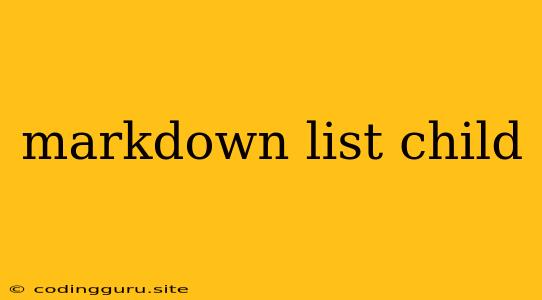Mastering Markdown Lists: A Guide to Creating Child Lists for Organization and Clarity
Markdown, a simple yet powerful markup language, is widely used for creating structured documents. One of its key features is the ability to create lists, which can be further enhanced by nesting child lists within parent lists. This allows you to organize information hierarchically, making your documents more readable and understandable.
What are Child Lists?
Child lists are lists that are nested within a parent list. They represent a lower level of hierarchy within the overall list structure. Think of it as a branching tree, where the parent list is the trunk, and the child lists are the branches.
Why Use Child Lists?
Using child lists offers several benefits:
- Enhanced Organization: They help you structure information logically, making it easier for readers to follow the flow of your content.
- Improved Clarity: Child lists visually distinguish between different levels of information, highlighting the relationships between items.
- Better Readability: By breaking down complex lists into smaller, digestible units, you improve the readability of your documents.
Creating Child Lists: A Step-by-Step Guide
To create a child list in Markdown, you simply indent the list items under the parent list. This can be done by adding four spaces or a tab character to the beginning of each child list item.
Here's an example:
- **Parent Item 1**
- Child Item 1.1
- Child Item 1.2
- **Parent Item 2**
- Child Item 2.1
- Grandchild Item 2.1.1
- Grandchild Item 2.1.2
- Child Item 2.2
This code produces the following output:
- Parent Item 1
- Child Item 1.1
- Child Item 1.2
- Parent Item 2
- Child Item 2.1
- Grandchild Item 2.1.1
- Grandchild Item 2.1.2
- Child Item 2.2
- Child Item 2.1
As you can see, the child lists are clearly indented under their respective parent items. You can even nest multiple levels of child lists, as demonstrated by the "Grandchild Items" in the example.
Tips for Using Child Lists Effectively
- Consistency: Use consistent indentation for your child lists to maintain visual clarity and a uniform look.
- Meaningful Grouping: Group related items under common parent items to make the list more meaningful and organized.
- Limit Nesting: While nested child lists can be useful, avoid excessively deep nesting as it can become difficult to follow.
- Context: Ensure that the child lists are relevant to their parent items and provide valuable context to the overall information.
Conclusion
Mastering the use of child lists in Markdown allows you to create organized and visually appealing documents. By effectively structuring information through nesting, you improve the readability and comprehensibility of your content. Remember to use child lists strategically to enhance the organization and clarity of your writing.
